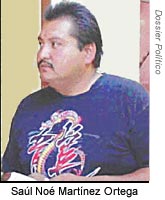New York, April 24, 2007—Saúl Noé Martínez Ortega, a Mexican crime reporter who had been abducted a week ago, was found dead yesterday morning in the northern state of Chihuahua. The Committee to Protect Journalists is investigating possible links between Martínez’s murder and his professional work.
Early yesterday morning, a passerby discovered a body wrapped in a blanket on a road outside the town of Nuevo Casas Grandes, near the border between the Chihuahua and Sonora states, according to press reports and CPJ interviews. The body, which was badly decomposed, was identified as that of Martínez through a silver tooth and a tattoo on his left shoulder, said the journalist’s brother, Erick Martínez Ortega.
Martínez, 36, was abducted on the night of April 16 outside a municipal police station in Agua Prieta, a city in the state of Sonora, on the Arizona border. Press reports said that after a high-speed chase, Martínez stopped his SUV at the entrance of the police station and called for help. But heavily armed gunmen forced the reporter into their vehicle and drove away from the city center.
The reporter had been dead for approximately six days, said José Larrinaga Talamantes, a spokesman for the state attorney general’s office in Hermosillo. He had been beaten and apparently died of a blow to the head, Erick Martínez told CPJ.
Martínez covered crime during night shifts for Interdiario, a family-owned newspaper in Agua Prieta that comes out three times a week, the journalist’s father, Lorenzo, told CPJ last week. According to Martínez’s family, he was investigating the disappearance of a friend who works as an informant for the municipal police. The Martínez family believes the slaying is related to his work on this case, Erick Martínez said.
Larrinaga told CPJ that state and federal authorities are conducting parallel investigations. Investigators are looking into several possible motives, including alleged links between the reporter and local drug traffickers, said the spokesman for the state attorney general’s office. Authorities have not ruled out Martínez’s journalism as a potential motive, Larrinaga said.
“We are saddened by the death of our colleague and offer our condolences to his family and friends,” said CPJ Executive Director Joel Simon. “We urge authorities in Sonora and at the federal level to conduct a speedy and thorough investigation into his slaying in order to bring all those responsible to justice.”
CPJ research shows that six journalists have been murdered in direct reprisal for their work in Mexico since 2000. CPJ is also investigating the circumstances surrounding the slayings of 11 other journalists since then to determine if those deaths are work-related. Three journalists have also disappeared since 2005. Two of them covered crime.
